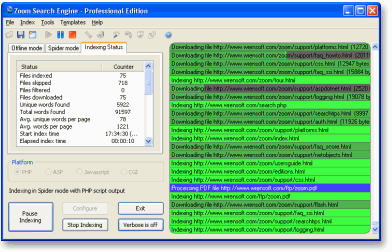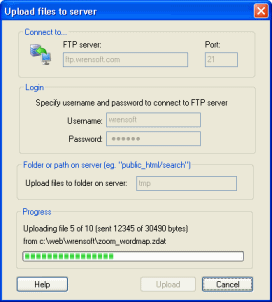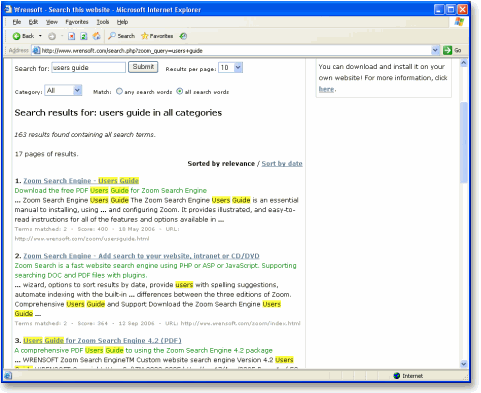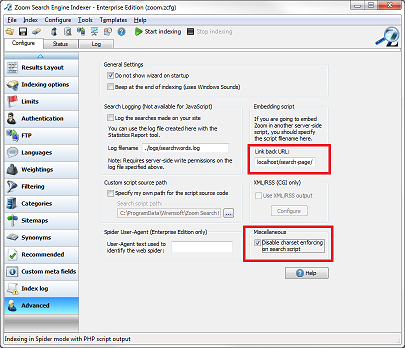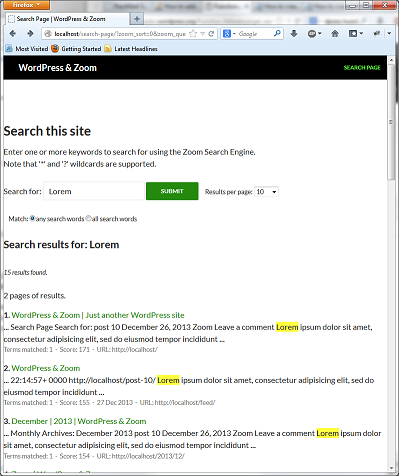How to create a search engine for your WordPress siteZoom Search Engine is a software package that allows you to create a powerful custom search engine for your website. It is unlike other search solutions in that it gives you full control over its indexing capabilities, and there is no advertising or annual fees, while being one of the easiest to use and most feature packed solutions on the market. More on the advantages of using Zoom here. Another key benefit in using Zoom on your WordPress site is that it can be hosted and indexed within an intranet. Other search services like Google Syndicated Search are remotely hosted, and require your website to be publicly accessible over the Internet. Searches will also need to occur with full Internet access, and you will have no control as to how often the index is updated or what pages should be included or excluded from the indexing. With Zoom, you can run and schedule the indexing yourself on any Windows computer on the network. The following article explains how to use Zoom with your WordPress website. We provide this tutorial to explain some common details and steps to get a working Zoom Search Engine up and running, and integrated with your WordPress web site as quickly as possible. What you will need
Zoom is free for small websites of up to 50 pages. For larger sites, commercial editions are available, with the Professional Edition being the most popular, which indexes up to 50,000 pages. Detailed comparison of the different editions available can be found here. Using Zoom and indexing your websiteUsing Zoom on a WordPress website is much the same as using it on any other website, so you will find much more detailed information on installing and running Zoom in the Users Guide (free PDF download). We recommend referring to the Users Guide for most instructions and taking note of the following tips for guidance/reference for WordPress specific details. But to summarize, Zoom has two main parts. The Indexer software which runs on your desktop computer, scans your website and generates a set of "index files". These files are then uploaded to your website and provide the searching functionality. You will also be using the Indexer to update your search engine when you make changes to your website in the future.
Once the files are correctly uploaded, you will be able to access your new search engine by entering in the URL to the search page in your web browser. For example, if you uploaded your files to a sub-folder named "zoom", your new search page will be at http://www.mysite.com/zoom/search.php Enter in some search words and give it a try!
As you will notice, the default search page is fairly blank, as it has not yet been customized to suit the look and feel of your website. In addition to this, we would want to integrate the search page within your WordPress site, and we will explain this below. Integrating your Zoom search page into WordPress
Easy:
However, if you want to further integrate the search page inside your WordPress website (so that it will maintain the same skinning and various modules you are using), then read on. Harder: Another option is to create a custom "Page Template" in WordPress that will include the search.php file from Zoom. (Note: Visit WordPress' site for more information and proper syntax & structure for creating Custom Page Templates.) Before we get started, there are some additional steps that needs to be done beforehand. We will need to make changes in WordPress and then in Zoom. The exact steps may vary depending on theme that is currently in use, but the general process is outlined below.
Your search should now be working. You will be able to customize the colours, fonts and overall look of the search page and search results by modifying the "search_template.html" page. Please see chapter 6 of the Users Guide ("How do I customize the look of my search page?") for more information.
Adding search boxes to your other web pagesYou may now be wondering how you can add search boxes on the other pages of your website. These boxes are often a simpler, smaller version of the search box you see on the search page that allows people to submit a simple search query from any where on the site. It will then take them to this search page with their results. To do this, you will need to modify your theme header to include additional HTML code.
<form method="get" action="http://www.mysite.com/zoom/search.php">
You will need to replace the URL in the above HTML (in bold) with the actual URL to the new search page that you created earlier. Note again that you may want to modify your "search_template.html" file to make your search page match the look and feel of the rest of your WordPress site. Now you have your very own custom search engine as part of your WordPress web site! I hope the above has been helpful in getting you up and running. There are many options and configurations possible with Zoom which you can fine-tune to your heart's content, including highlighting, categories, and more. Please download a copy of the Users Guide for more information. Enjoy your new search engine! TroubleshootingIf you have any problems with indexing your website, you should refer to our extensive online support section for help. There is also a Discussion Forum for seeking and sharing tips and advice.
Return to the Zoom Search Engine website |
